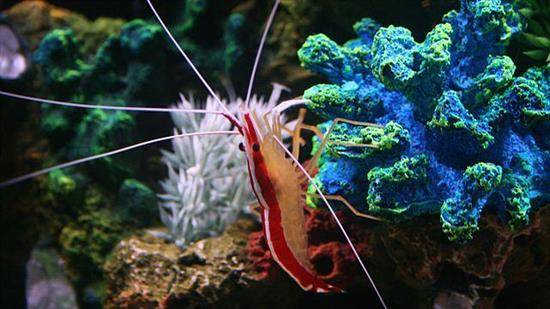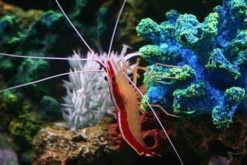Cleaner Shrimp (Lysmata amboinensis)
- Care Level: Easy
- Temperament: Peaceful
- Diet: Omnivore
- Reef Safe: Yes
- Minimum Tank Size: 10 gallons
- Nature Max Size: Up to 2 inches
- Water Parameters: pH 8.1-8.4, Salinity 1.023-1.025, Temperature 72-78°F
Comprehensive Guide to the Cleaner Shrimp (Lysmata amboinensis)
Habitat
The Cleaner Shrimp (Lysmata amboinensis), also known as the Scarlet Skunk Cleaner Shrimp, is found in the Indo-Pacific region, particularly in the waters of the Indian Ocean and the western Pacific Ocean. It inhabits coral reefs and rocky areas.
Reef Safe and Reef Cleaning Behavior
The Cleaner Shrimp is considered reef safe as it does not harm corals or other invertebrates. In fact, it plays a vital role in maintaining the health of a reef aquarium by acting as a cleaner. It will actively clean parasites and dead skin off fish, which helps to prevent diseases and maintain the overall well-being of the aquarium inhabitants.
Size
The Cleaner Shrimp can grow up to 2 inches in size, making it a relatively small species suitable for smaller saltwater aquariums.
Sexual Dimorphism
The male Cleaner Shrimp is usually smaller and more slender compared to the larger and rounder female. Females may also have a more pronounced red coloration.
Lifespan
The average lifespan of the Cleaner Shrimp is around 2-3 years, although with proper care, some individuals may live longer.
Diet in Aquariums
In the aquarium, the Cleaner Shrimp is an omnivorous scavenger. It will feed on a variety of foods, including small meaty foods like brine shrimp, mysis shrimp, and fish flakes. It will also scavenge for leftover food and detritus in the aquarium.
Aquaculture and Availability
The Cleaner Shrimp is commonly aquacultured, which means it is bred in captivity. This makes it readily available to hobbyists and reduces the impact on wild populations. Reefs4Less.com offers aquacultured Cleaner Shrimp, ensuring sustainable sourcing.
Compatibility with Tankmates
The Cleaner Shrimp is generally peaceful and can be kept with a variety of fish, invertebrates, and corals. However, caution should be exercised when introducing it to aggressive or predatory species that may harm or eat the shrimp. Here are five tankmates that are good choices:
- Clownfish: Clownfish are known for their symbiotic relationship with anemones. The Cleaner Shrimp can help keep the anemones clean and free from parasites.
- Gobies: Gobies are small, peaceful fish that can coexist with Cleaner Shrimp. They can benefit from the shrimp’s cleaning behavior.
- Hermit Crabs: Hermit crabs are scavengers, and the Cleaner Shrimp can help keep their shells clean. They generally get along well together.
- Soft Corals: Cleaner Shrimp do not harm corals and can be kept in reef aquariums with soft corals. They can help maintain the cleanliness of the coral colonies.
- Firefish: Firefish are peaceful and can coexist with Cleaner Shrimp. They make a colorful addition to the aquarium.
Temperament
The Cleaner Shrimp is known for its peaceful temperament. It is generally non-aggressive towards other tank inhabitants and can be kept in community aquariums.
Other Common Names
The Cleaner Shrimp (Lysmata amboinensis) is also known as the Scarlet Skunk Cleaner Shrimp or the Indo-Pacific White-Banded Cleaner Shrimp.
Why Buy from Reefs4Less.com
Reefs4Less.com is a reputable online retailer that offers a wide range of saltwater aquarium livestock and supplies. They prioritize sustainability by offering aquacultured Cleaner Shrimp, ensuring the health and well-being of the species and reducing the impact on wild populations. Their products are of high quality, and they provide reliable shipping and customer service.
Frequently Asked Questions about the Cleaner Shrimp (Lysmata amboinensis)
1. Can the Cleaner Shrimp be kept with aggressive fish?
It is generally not recommended to keep the Cleaner Shrimp with aggressive or predatory fish that may harm or eat the shrimp. It is best to choose tankmates that are peaceful and compatible with the shrimp’s peaceful temperament.
2. How often should the Cleaner Shrimp be fed?
The Cleaner Shrimp should be fed small amounts of food multiple times a day. It is important to offer a varied diet to ensure their nutritional needs are met.
3. Can the Cleaner Shrimp be housed in a small tank?
The Cleaner Shrimp can be housed in a smaller tank, but it is recommended to provide at least a 10-gallon tank to ensure an adequate swimming space and proper water quality.
4. Do Cleaner Shrimp reproduce in captivity?
While Cleaner Shrimp can reproduce in captivity, it is more challenging compared to other species. Breeding requires specific conditions and may not occur spontaneously in a home aquarium.
5. Can the Cleaner Shrimp jump out of the aquarium?
The Cleaner Shrimp is not known for being a jumper. However, it is always a good practice to have a secure lid or cover on the aquarium to prevent any accidental escapes.



Reviews
There are no reviews yet.